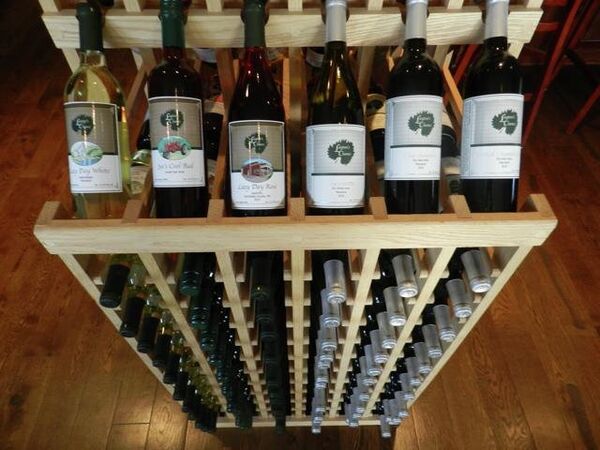Dairy farmers opening ice cream shops, grain farmers making wine, fruit farmers producing their very own fruit drinks, it’s happening all across America, as farmers look for new ways to stay in business.
“It certainly would’ve seemed crazy to me ten years ago, but it was really a matter of necessity,” said Joe Layton, one of the owners of Lazy Day Farms in the state of Maryland.
Layton’s dad bought the farm in 1948 and the Layton family has been farming in the area for several generations.
With children and grandchildren to consider, the Laytons decided to diversify their 1800-acre grain farm and planted their first grapes in 2007, joining Maryland’s growing wine industry.
This year, Layton’s Chance Vineyard and Winery is expected to produce 8,000 gallons of red and white wine, roughly 40,000 bottles that retail for up to $20 each.
“It’s a big deal,” Layton said. “It’s allowed us to be viable for the foreseeable future.”
In doing what they felt they needed to do to ensure the survival of Lazy Day Farms, the Laytons became part of a growing trend among farm families in the U.S.
“There are great opportunities for farmers of all types to become involved in direct-to-consumer sales, and it’s happening on many levels,” said Sabrina Matteson, Director of Rural Affairs for the American Farm Bureau Federation.
“Those that want to capitalize on an increased profit margin find there’s an opportunity to bring the next generation into the family farm,” said Matteson.
That’s what motivated Chuck Fry to expand the dairy farm his family has owned near Washington, DC since 1883.
Milk prices in the U.S. are particularly volatile and unpredictable, part of the reason for a sharp drop in the number of dairy farms nationwide.
Even with hundreds of acres of crops and more than 200 dairy cows, Fry and his wife Paula weren’t sure it would be enough for their children and grandchildren to make a living on.
“What’s the most troubling in the hearts of farmers is, where are we going to get the next generation to carry on this legacy,” Fry said.
The Frys opened Rocky Point Creamery on their farm last year, selling up to 43 flavors, about 3,500 scoops of ice cream every month. Already the creamery accounts for 25% of the farm’s profits.
Rocky Point is one of at least seven dairy farm ice cream shops in the state of Maryland, and there are more in other parts of the U.S.
“At this point we have extremely capable dairy farmers,” said Mark Powell, a spokesman for the Maryland Department of Agriculture.
“The similarity in all of them is they decided they needed to diversify. They’re trying to tap into the demand for local produce and get direct income for the farm,” Powell added.
And farmers are quick to jump on opportunities to capitalize on that demand. Less than two months after a new law went into effect in Maryland, allowing farmers to produce and sell beer using grains or fruits grown on their land, at least six farm breweries are gearing up for production.
Holly Foster is convinced the dairy farm she and her husband own on Maryland’s eastern shore would have failed had they not decided to branch out into making and selling cheese, adding value to their milk product and generating additional profits for the farm.
“If we had not taken the value-added road, we would have really been in some serious trouble,” she said. “It would have been an extreme struggle and I think we would have tossed in the towel if it weren’t for the cheese.”
The cheese can take up to a year to age properly, and it has to be stored in carefully regulated conditions, but it churns a healthy profit. A gallon of milk sells for about $1.75, and the same amount of milk turned into cheese can be sold for as much as $20.
“It’s an investment,” Foster said, one that has paid off handsomely.
For Allyn Brown III, the owner of Maple Lane Farm in the state of Connecticut, diversifying his product was also a kind of insurance.
Brown grows Christmas trees, as well as strawberries, blueberries, apples, raspberries, and his farm is the biggest producer of black currants in the United States. With his own bottling plant, Brown produces natural fruit drinks sold in supermarket produce sections.
“This year we had a big freeze in the spring and lost a lot of apples and currants, but that just shows you have to have multiple income sources so you can weather these storms,” he said. “It costs the same to grow an apple crop with 20% yield as it does to grow one with 100% yield.”
“Direct-to-consumer is part of being diversified,” Brown said.
With a new generation of social-media-savvy young farmers, selling to consumers is giving the agricultural industry greater income control, and for many farming families, that means a new kind of stability their forefathers didn’t have.
In the past you were more often in the position of being a price-taker, where you just had to accept whatever the price was, not a price-maker,” said Gary Matteson of the Farm Credit Council.
Joe Layton says his winery is unique, but the concept is not unusual. And it may hold the secret for farmers nationwide who are hoping to keep their farms in the family and growing for generations to come.
“Many, many farmers are looking for sidelines, whether it’s raising vegetables and having a produce stand or something to stabilize the income,” he said. “Farming is so unpredictable.”


